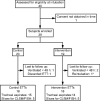Silver-Coated Endotracheal Tubes Cleaned With a Mechanism for Secretion Removal
- PMID: 30181363
- PMCID: PMC10068633
- DOI: 10.4187/respcare.06222
Silver-Coated Endotracheal Tubes Cleaned With a Mechanism for Secretion Removal
Abstract
Background: Biofilm on the surface of endotracheal tubes (ETTs) is associated with ventilator-associated pneumonia. The use of silver-coated ETTs has been suggested to reduce the occurrence of ventilator-associated pneumonia by preventing biofilm formation. However, mucus accumulation can reduce the antibacterial activity of silver-coated ETTs by isolating bacterial colonies from the silver surface. We hypothesized that, in mechanically ventilated subjects, periodic removal of secretions through the use of a cleaning device would enhance the antimicrobial properties of silver-coated ETTs and thus reduce bacterial colonization.
Methods: Subjects were randomized to either standard suctioning (blind tracheal suctioning, control group) or blind tracheal suctioning plus cleaning maneuver every 8 h (treatment group). Tracheal aspirates were collected immediately before extubation for microbiological culture. After extubation, ETTs were collected for both cultural and non-cultural microbiological analysis and biofilm isolation.
Results: 39 subjects expected to be ventilated for > 48 h were enrolled; 36 ETTs (18 control, 18 treatment) and 29 tracheal samples (15 control, 14 treatment) were collected. Among the ETTs positive for bacterial colonization (15 vs 9, P = .18), cleaning maneuvers did not reduce microbial load, shown as the decimal logarithm of colony-forming units (CFU) per mL (1.6 ± 1.2 vs 0.9 ± 1.2 logCFU/mL, P = .15). There was a trend toward decreased biofilm deposition (439.5 ± 29.0 vs 288.9 ± 157.7 mg, P = .09) in the treated ETTs. No significant differences were observed in the number of positive tracheal aspirates (13 vs 10, P = .39) or in the microbial load (4.8 ± 4.0 vs 4.2 ± 3.8 logCFU/mL, P = .70) of tracheal secretions. Finally, no differences in the microbial load of Gram-positive organisms, Gram-negative organisms, or yeasts were found between the ETTs and tracheal aspirates of the 2 groups.
Conclusions: In 39 critically-ill subjects intubated with silver-coated ETTs, periodic cleaning maneuvers did not decrease bacterial colonization of the ETTs and did not lower respiratory tract colonization compared to the standard suctioning. (Clinicaltrials.gov registration NCT02120001.).
Keywords: airway management; airway obstruction; biofilms; intubation; pneumonia; ventilation; ventilator-associated pneumonia.
Copyright © 2019 by Daedalus Enterprises.
Figures



Comment in
-
Improved Endotracheal Tubes for Prevention of Ventilator-Associated Pneumonia: Better Than Silver and Gold?Respir Care. 2019 Jan;64(1):108-109. doi: 10.4187/respcare.06698. Respir Care. 2019. PMID: 30578362 No abstract available.
References
-
- Danin PE, Girou E, Legrand P, Louis B, Fodil R, Christov C, et al. . Description and microbiology of endotracheal tube biofilm in mechanically ventilated subjects. Respir Care 2015;60(1):21–29. - PubMed
-
- Pirrone M, Pinciroli R, Berra L. Microbiome, biofilms, and pneumonia in the ICU. Curr Opin Infect Dis 2016;29(2):160–166. - PubMed
-
- Mietto C, Pinciroli R, Piriyapatsom A, Thomas JG, Bry L, Delaney ML, et al. . Tracheal tube obstruction in mechanically ventilated patients assessed by high-resolution computed tomography. Anesthesiology 2014;121(6):1226–1235. - PubMed
Publication types
MeSH terms
Substances
Associated data
Grants and funding
LinkOut - more resources
Full Text Sources
Other Literature Sources
Medical

